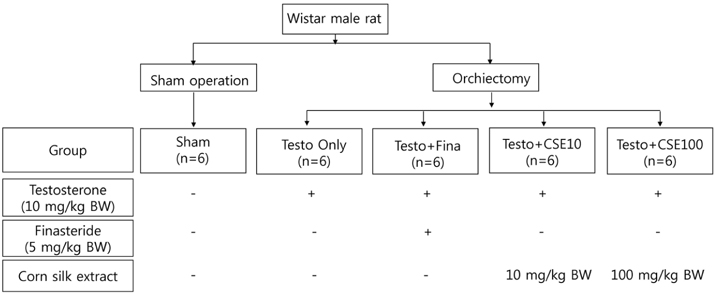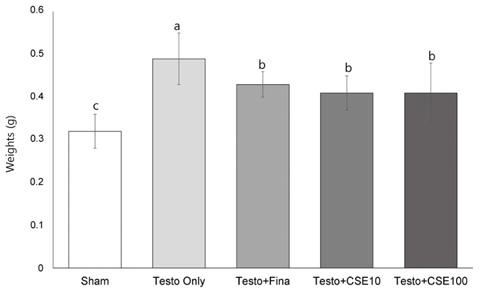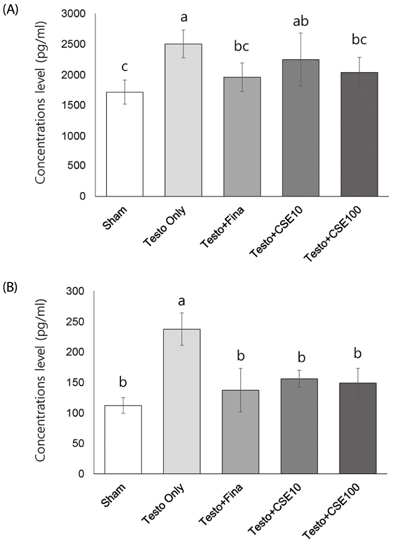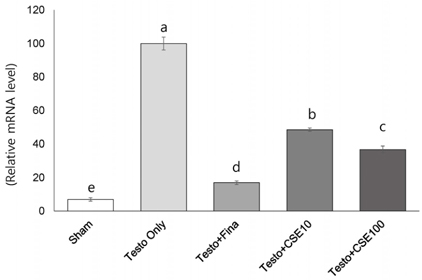Nutr Res Pract.
2017 Oct;11(5):373-380. 10.4162/nrp.2017.11.5.373.
Corn silk extract improves benign prostatic hyperplasia in experimental rat model
- Affiliations
-
- 1Department of Food Science and Nutrition, Dankook University, 119, Dandae-ro, Dongnam-gu, Cheonan-si, Chungnam 31116, Korea. wkkim@dankook.ac.kr
- 2Department of Food Science and Nutrition, Natural Nutraceuticals Industrization Research Center, DanKook University, Chungnam 31116, Korea.
- 3Crop Foundation Division National Institute of Crop Science, RDA, Jeonbuk 55365, Korea.
- 4Crop Post-harvest Technology Division, National Institute of Crop Science, RDA, Suwon, Gyeonggi 16613, Korea.
- 5Department of Food Engineering, Dankook University, Chungnam 31116, Korea.
- KMID: 2390129
- DOI: http://doi.org/10.4162/nrp.2017.11.5.373
Abstract
- BACKGROUND/OBJECTIVES
This study was conducted to investigate the effect of a corn silk extract on improving benign prostatic hyperplasia (BPH).
MATERIALS/METHODS
The experimental animals, 6-week-old male Wistar rats, were divided into sham-operated control (Sham) and experimental groups. The experimental group, which underwent orchiectomy and received subcutaneous injection of 10 mg/kg of testosterone propionate to induce BPH, was divided into a Testo Only group that received only testosterone, a Testo+Fina group that received testosterone and 5 mg/kg finasteride, a Testo+CSE10 group that received testosterone and 10 mg/kg of corn silk extract, and a Testo+CSE100 group that received testosterone and 100 mg/kg of corn silk extract. Prostate weight and concentrations of dihydrotestosterone (DHT), 5α-reductase 2 (5α-R2), and prostate specific antigen (PSA) in serum or prostate tissue were determined. The mRNA expressions of 5α-R2 and proliferating cell nuclear antigen (PCNA) in prostate tissue were also measured.
RESULTS
Compared to the Sham group, prostate weight was significantly higher in the Testo Only group and decreased significantly in the Testo+Fina, Testo+CSE10, and Testo+CSE100 groups (P < 0.05), results that were consistent with those for serum DHT concentrations. The concentrations of 5α-R2 in serum and prostate as well as the mRNA expression of 5α-R2 in prostate were significantly lower in the Testo+Fina, Testo+CSE10, and Testo+CSE100 groups than that in the Testo Only group (P < 0.05). Similarly, the concentrations of PSA in serum and prostate were significantly lower in the Testo+Fina, Testo+CSE10, and Testo+CSE100 groups (P < 0.05) than in the Testo Only group. The mRNA expression of PCNA in prostate dose-independently decreased in the Testo+CSE-treated groups (P < 0.05).
CONCLUSIONS
BPH was induced through injection of testosterone, and corn silk extract treatment improved BPH symptoms by inhibiting the mRNA expression of 5α-R2 and decreasing the amount of 5α-R2, DHT, and PSA in serum and prostate tissue.
Keyword
MeSH Terms
-
Animals
Dihydrotestosterone
Finasteride
Humans
Injections, Subcutaneous
Male
Models, Animal*
Orchiectomy
Proliferating Cell Nuclear Antigen
Prostate
Prostate-Specific Antigen
Prostatic Hyperplasia*
Rats*
Rats, Wistar
RNA, Messenger
Silk*
Testosterone
Testosterone Propionate
Zea mays*
Dihydrotestosterone
Finasteride
Proliferating Cell Nuclear Antigen
Prostate-Specific Antigen
RNA, Messenger
Silk
Testosterone
Testosterone Propionate
Figure
Reference
-
1. Hasanudin K, Hashim P, Mustafa S. Corn silk (Stigma maydis) in healthcare: a phytochemical and pharmacological review. Molecules. 2012; 17:9697–9715.
Article2. Grases F, March JG, Ramis M, Costa-Bauzá A. The influence of Zea mays on urinary risk factors for kidney stones in rats. Phytother Res. 1993; 7:146–149.
Article3. Min OJ, Sharma BR, Park CM, Rhyu DY. Effect of myadis stigma water extract on adipogenesis and blood glucose in 3T3-L1 adipocytes and db/db mice. Korean J Pharmacogn. 2011; 42:201–208.4. Kim SL, Kim MJ, Lee YY, Jung GH, Son BY, Lee JS, Kwon YU, Park YI. Isolation and identification of flavonoids from corn silk. Korean J Crop Sci. 2014; 59:435–444.
Article5. Byrne PF, McMullen MD, Snook ME, Musket TA, Theuri JM, Widstrom NW, Wiseman BR, Coe EH. Quantitative trait loci and metabolic pathways: genetic control of the concentration of maysin, a corn earworm resistance factor, in maize silks. Proc Natl Acad Sci U S A. 1996; 93:8820–8825.
Article6. Lee YJ, Lee JW, Park J, Seo SI, Chung JI, Yoo TK, Son H. Nationwide incidence and treatment pattern of benign prostatic hyperplasia in Korea. Investig Clin Urol. 2016; 57:424–430.
Article7. Unnikrishnan R, Almassi N, Fareed K. Benign prostatic hyperplasia: evaluation and medical management in primary care. Cleve Clin J Med. 2017; 84:53–64.
Article8. Cho SH, Han YH, Kim YS. Effects of bee venom herbal acupuncture on experimental rat model of benign prostatic hyperplasia. J Korean Orient Intern Med. 2010; 31:166–176.9. Roehrborn CG. Pathology of benign prostatic hyperplasia. Int J Impot Res. 2008; 20:Suppl 3. S11–S18.
Article10. Bartsch G, Rittmaster RS, Klocker H. Dihydrotestosterone and the concept of 5alpha-reductase inhibition in human benign prostatic hyperplasia. World J Urol. 2002; 19:413–425.
Article11. Hirshburg JM, Kelsey PA, Therrien CA, Gavino AC, Reichenberg JS. Adverse effects and safety of 5-alpha reductase inhibitors (finasteride, dutasteride): a systematic review. J Clin Aesthet Dermatol. 2016; 9:56–62.12. Guo M, Heran B, Flannigan R, Kezouh A, Etminan M. Persistent sexual dysfunction with finasteride 1 mg taken for hair loss. Pharmacotherapy. 2016; 36:1180–1184.
Article13. Kang HS, Kim GY, Jung I, Oh SD, Kim CH, Shim BS, Park KH, Oh SJ. The effect of the compound of tomato extract to the prostatic cancer cell and the prostate of the rat model of benign prostatic hyperplasia. Korean J Pharmacogn. 2007; 38:197–203.14. Mobley D, Feibus A, Baum N. Benign prostatic hyperplasia and urinary symptoms: evaluation and treatment. Postgrad Med. 2015; 127:301–307.
Article15. Lee SJ, Choi HR, Lee JH, Kwon JW, Lee HK, Jeong JT, Lee TB. Effects of unripe black raspberry extracts on prostate cancer cell line and rat model of benign prostatic hyperplasia. J Korean Soc Food Sci Nutr. 2014; 43:507–515.
Article16. Moon JM, Seok GH, Cho SI. Antiproliferative effect of schisandrae fructus extract on PC-3 human prostate cancer cells. Korean J Herbol. 2012; 27:17–23.
Article17. Singh NK, Sahu AN, Singh SK. Free radical scavenging and hepatoprotective activities of standardized methanolic Extract of Maydis Stigma. Pharmacologyonline. 2009; 2:440–449.18. Liu J, Wang C, Wang Z, Zhang C, Lu S, Liu J. The antioxidant and free-radical scavenging activities of extract and fractions from corn silk (Zea mays L.) and related flavone glycosides. Food Chem. 2011; 126:261–269.
Article19. Al-Ali M, Wahbi S, Twaij H, Al-Badr A. Tribulus terrestris: preliminary study of its diuretic and contractile effects and comparison with Zea mays. J Ethnopharmacol. 2003; 85:257–260.
Article20. Lee EY, Kim SL, Kang HJ, Kim MH, Ha AW, Kim WK. High maysin corn silk extract reduces body weight and fat deposition in C57BL/6J mice fed high-fat diets. Nutr Res Pract. 2016; 10:575–582.
Article21. Lee J, Kim SL, Lee S, Chung MJ, Park YI. Immunostimulating activity of maysin isolated from corn silk in murine RAW 264.7 macrophages. BMB Rep. 2014; 47:382–387.
Article22. Lee J, Lee S, Kim SL, Choi JW, Seo JY, Choi DJ, Park YI. Corn silk maysin induces apoptotic cell death in PC-3 prostate cancer cells via mitochondria-dependent pathway. Life Sci. 2014; 119:47–55.
Article23. Lee DH, Lee JS, Kim YS. The effects of lygodium japonicum on experimental rat model of benign prostatic hyperplasia. J Korean Orient Intern Med. 2010; 31:457–466.24. Park DJ, Kang SH, Cho YH. The antihyperplastic effect of oral catechin ingestion in a rat model of benign prostatic hyperplasia. Korean J Urol. 2006; 47:1289–1293.
Article25. Wu X, Gu Y, Li L. The anti-hyperplasia, anti-oxidative and anti-inflammatory properties of Qing Ye Dan and swertiamarin in testosterone-induced benign prostatic hyperplasia in rats. Toxicol Lett. 2017; 265:9–16.
Article26. Cha JH, Kim SR, Kang HJ, Kim MH, Ha AW, Kim WK. Corn silk extract improves cholesterol metabolism in C57BL/6J mouse fed high-fat diets. Nutr Res Pract. 2016; 10:501–506.
Article27. Reeves PG. Components of the AIN-93 diets as improvements in the AIN-76A diet. J Nutr. 1997; 127:838S–841S.
Article28. Park JS, Moon JH, Huh JS, Kong MH, Kim HJ. Comparison of correlation between prostate volume and obesity indices. Korean J Obes. 2015; 24:95–100.
Article29. Bruchovsky N, Lesser B, Van Doorn E, Craven S. Hormonal effects on cell proliferation in rat prostate. Vitam Horm. 1975; 33:61–102.
Article30. Afriyie DK, Asare GA, Bugyei K, Adjei S, Lin JM, Peng J, Hong ZF. Treatment of benign prostatic hyperplasia with Croton membranaceus in an experimental animal model. J Ethnopharmacol. 2014; 157:90–98.
Article31. Kim CW, Lee KH. Effects of paljeong-san pharmacopuncture on experimental rat model of benign prostatic hyperplasia. J Korean Acupunct Moxibustion Soc. 2014; 31:95–103.
Article32. Jaskulski D, Gatti C, Travali S, Calabretta B, Baserga R. Regulation of the proliferating cell nuclear antigen cyclin and thymidine kinase mRNA levels by growth factors. J Biol Chem. 1988; 263:10175–10179.
Article33. Zhong W, Peng J, He H, Wu D, Han Z, Bi X, Dai Q. Ki-67 and PCNA expression in prostate cancer and benign prostatic hyperplasia. Clin Invest Med. 2008; 31:E8–E15.
Article34. Zhong X, Lin J, Zhou J, Xu W, Hong Z. Anti-proliferative effects of qianliening capsules on prostatic hyperplasia in vitro and in vivo. Mol Med Rep. 2015; 12:1699–1708.
Article
- Full Text Links
- Actions
-
Cited
- CITED
-
- Close
- Share
- Similar articles
-
- A Prominently Large Glans penis as a Possible sign of Benign Prostatic Hyperplasia
- The Antihyperplastic Effect of Oral Catechin Ingestion in a Rat Model of Benign Prostatic Hyperplasia
- Ethanol Extract of Chaenomeles sinensis Inhibits the Development of Benign Prostatic Hyperplasia by Exhibiting Anti-oxidant and Anti-inflammatory Effects
- Benign Prostatic Hyperplasia and Alpha Adrenoceptor Blockers
- The Effects of Abdominal Obesity on the Increased Prevalence Rate of Hypertension and Diabetes Mellitus in Benign Prostatic Hyperplasia Patients








